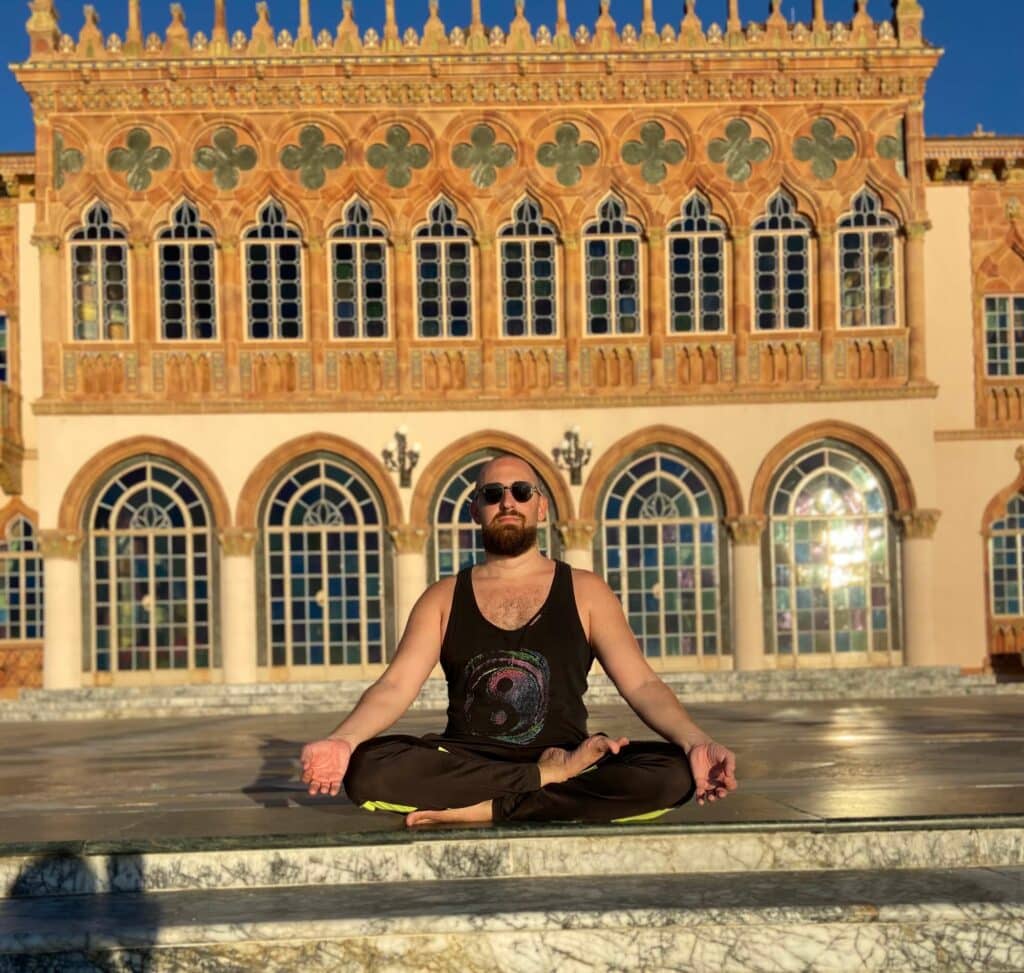
It’s NOT EASY To Make A Living As A Meditation Teacher (but it is possible!)
According to GlassDoor, the average meditation teacher in the US takes home between $51K – $88K per year.
To put it frankly: that’s BS.
GlassDoor’s data may represent the (relatively small number of) meditation teachers who work as full-time employees for retreat centers, studios, meditation platforms, etc… but they don’t reflect the real-world experience of the average meditation teacher.
The hard truth that most MTTs don’t want you to know is that many aspiring meditation teachers struggle to make a living by teaching meditation, so they give up and end up working in other jobs or careers instead. Sad, but true.
At the other end of the spectrum… we’ve all seen those high-profile meditation teachers/popularizers who become rich and famous through their spiritual teaching/writing/publicizing practices. Deepak Chopra, Eckhart Tolle, Jay Shetty, and Andy Puddicomb (founder of Headspace) are just a few examples. You can see many more of these “meditation celebrities” on the covers of Meditation Magazine 🙂 And for every meditation celebrity making bank from their teachings, there are hundreds (thousands?) of “low-profile” meditation teachers — mainly concentrated in major metros like NYC, LA, etc — who are quietly making six, seven, and even eight figures as well.
Why is there such a huge income disparity for struggling vs “successful” meditation teachers?
“Meditation Teacher” is not a traditional career path that has widespread institutions and systems in place. While a lawyer, schoolteacher, or therapist may fit neatly into “the system” — with thousands of jobs and positions to choose from — meditation teachers often need to blaze their own trails, start their own businesses, and work for themselves.
Highly talented meditation teachers who are able to differentiate themselves, write books, create courses, or build businesses around their work, are often able to thrive financially.
But passionate meditation teachers who don’t know how to “stand out” or monetize their work often find themselves struggling.
There is a wide swath of the “meditation teacher” population that has essentially given up on the idea of making a full-time living from teaching meditation, so they offer meditations occasionally (if ever), haphazardly, “on the side” of another career, as a kind of hobby, sometimes for free or for small amounts of money.
Many spend years trying in vain to create large social media followings like the successful influencers that they are trying to emulate. Some spend months writing and self-publishing books on Amazon, and only have a few people read their work. Some organize classes at local gyms and yoga studios, only to find a handful of people attending each week.
Why would anyone decide to work in such a financially challenging profession?
Why would anyone want to dedicate so much time, energy, and attention to such a challenging career path?
Because we LOVE meditation.
Meditation changed our lives, radically, profoundly, powerfully — and we want to help others experience the same kinds of transformation.
We live our lives in, and through, meditation. Everything else that arises life is just fleeting phenomena. The mundane world of thought and action is a fleeting illusion, flickering upon the screen of consciousness. Meditation, mindfulness, equanimity, awareness — that is the foundation. That is the core. We want to make meditation the center of our lives… and that is hard to reconcile with working 50 hours per week in a cubicle, pouring all of our attention (our consciousness, our life energy) into technical details or soul-sucking paperwork.
I’ve held high-profile, high-paying positions in management, tech and real estate in the past. The money was good, and the lifestyle was fun, but I quit every job and left every position when I started to feel like I was wasting my life doing something that really didn’t matter to me, observing my own boredom while sitting at board room tables, sprinting urgently to fix problems that ultimately didn’t matter.
I remember the moment that I knew I would leave my last job (managing software development for a real estate tech startup). I was interviewing an applicant who was applying to be a developer. The kid didn’t even seem like he wanted to be a developer; he was just there, in that meeting, because he believed he was supposed to be. His glazed eyes and pre-packaged answers to my (pre-packaged) interview questions reflected something in me: I didn’t want to be there either. I was just doing it because I felt I was supposed to be. There is a kind of soul-pain that arises in those moments: a yearning to be doing work that is actually meaningful. I knew in that moment that I would end up going “back” to meditation as a career path. It was, and has always been (well, at least since that moment in Wat Suan Mokkh) the only path for me.
I’ve been working in the field of mindfulness & meditation ever since I realized my life’s mission, back at Wat Suan Mokkh (Buddhist monastery in Thailand) in 2010. I’ve had my ups and downs, and sometimes I needed to go into other jobs and careers as well. But I went full-time into the field of Meditation when the pandemic hit in early 2020. It has not been easy, but it has been extremely fulfilling, and I don’t plan on going back to the corporate world any time soon 🙂 You can read more about my personal meditation career path here.
As challenging as it can be to make a living in the field of meditation, IT IS POSSIBLE!
From what I’ve seen, there are three basic career paths that are viable/sustainable for meditation teachers:
- Contractor
- Entrepreneur
- Integrator
1. The Contractor
The contractor path is pretty straightforward. You go to gyms, hospitals, schools, corporations, retreat centers, resorts, spas, local governments, municipalities, etc… and offer your services as a meditation teacher.
Sometimes, in rare cases, you may find a Meditation Teacher job as a full-time employee… but those jobs are few and far between, so it is much more likely you’ll find a bunch of contractor positions at various institutions instead.
This is how I started after coming back to the US from Thailand: I went to recreation centers and hospitals and got weekly gigs teaching meditation classes. Some gigs were paid, some were volunteer. They paid $16-$25/hr, which was a nice little income stream for me at the time, but not enough for a full-time income.
From my own experience, and what I’ve seen in others, this path is simple to get started, but it is difficult to sustain long-term, because the hourly pay is pretty low, and you have to keep bouncing from location to location, so it takes a lot of your time.
Freelancing can be a great way for new teachers to get their feet wet and gain experience, but unless you are independently wealthy or have another source of income, it can be a relatively low-paying path that is difficult to sustain in the long term.
2. The Entrepreneur
The best way that I have personally experienced, to make a living as a spiritual teacher / meditation popularizer, is to create a brand and business with lots of free entry points, and a “ladder” of paid offerings.
OK, that sounds confusing and overwhelming. Let me give you an example:
This blog post that you’re reading right now is one of many free “entry points” where people begin to engage with my brands and businesses (Meditation Magazine and Meditation University).
This blog post is completely free for you to read, and it doesn’t hold anything back. It’s real, raw, honest and vulnerable. It’s helpful, and it provides you with insight, information, and experience that you can use in your quest to figure out what you want to do with your own life and career.
You may have found this blog post on Google, or even from a paid advertisement on Facebook. That’s because I’ve taken steps to make sure this article is easy for new meditation teachers to find.
This blog post is written specifically for people who want to develop careers as meditation teachers, but are not sure if that’s what they really want to do with their lives.
Because it’s written directly for that person, it powerfully grabs the attention of anyone who is within that demographic. It gets them to click, read with rapt attention, and even click on the links in the article for more information. You know this to be true, because if you’ve gotten this far into this blog post… I’m talking specifically about YOU.
I have hundreds of other entry points as well. For example: my (free) YouTube videos, blog posts, and articles are watched and read by thousands of people per year. Those (free) videos, posts, and articles catch the attention of the specific type of people that could use my help.
Some people just read & watch my free offerings (like this blog post) and gain some benefit from that. Others decide to go deeper, and engage with my paid offerings — magazines, books, online meditation courses, personal meditation coaching, Meditation Teacher Training, etc.
My paid offerings are also at a wide variety of price points. They are arranged as a kind of “value ladder.” Magazines, books, and online courses are not too expensive… ranging from a few dollars to a few hundred dollars. The price point is low enough for people to impulsively jump in and try it out.
Low-ticket items also serve as stepping stones to higher-ticket-items that some people decide to engage with. For example, if you read Meditation Magazine, you may see an ad for one of my online courses. And if you take one of my online courses, you might decide to reach out to me after the course for one-on-one coaching.
This is just how my personal career is set up at the moment. In case you’re wondering, most of my personal income comes from my online meditation courses and one-on-one meditation coaching.
Other meditation entrepreneurs — some of whom teach alongside me in Meditation University’s award-winning Meditation Teacher Training program — use other entry points (like social media, local meditation events, etc), and other offerings (like corporate workshops, meditation retreats, etc) — but when it comes to building a business, this general format (free entry points → paid offerings) tends to work very well.
I’ve found that our MTT-200 graduates who follow this general “free entry points → paid offerings” business model tend to get more traction, and are able to build sustainable/scalable careers for themselves.
3. The Integrator
Another great way to create a sustainable career as a meditation teacher is to integrate meditation into an existing career path.
Of the hundreds of students who have graduated from our MTT, I’ve found that the ones who are able to make big things happen right away are the ones who are already working in “helping” fields like education and healthcare.
Schoolteachers and nurses, for example, are perfectly positioned to integrate mindfulness & meditation into their schools and hospitals. This can begin simply, by simply adjusting the words you use when speaking to students & patients… or it can evolve into major changes in your classroom, curriculum, programs, or procedures. Some of our graduates have even gone on to help develop and oversee regional-level programs, affecting entire school districts and hospital chains.
These large-scale initiatives can make a positive impact in the lives of thousands of people, and can also come with pay-raises, stipends, and even additional salary benefits as well.
Combination Paths
These three career paths can also be combined in various ways.
For example, my experience teaching in-person classes as a contractor helped me deepen my understanding of how people learn meditation, refine my teaching methods, write better books, create better online courses, etc.
I’ve also seen schoolteachers create curricula for their own schools, and then branch out as private business owners as well.
There are many ways to combine these paths, and there are other paths as well. If you’ve successfully developed another type of career path as a meditation teacher, please feel free to reach out and tell me about it!
Practical Advice For Getting Started
As a meditator, you know yourself in a deep way. You know your own strengths and weaknesses. You know which of the above career paths (if any) makes the most sense for you.
While the career paths outlined above may be relatively simple to understand, they do take a lot of time, effort, and work to actually get them rolling.
You can use the above information to get started on your own, but if you’d like additional assistance, please feel free to book a free consult with me.
I’d also recommend taking a look at Meditation University’s comprehensive Meditation Teacher Training Program, which is ranked as one of the best in the world — not only for developing your knowledge (learning dozens of meditation techniques from 12 world-renowned meditation teachers from various meditative traditions to help you on your journey), personal practice (through our 3-month meditation in action), and teaching experience & confidence (through weekly “practice circles” where you can practice teaching meditation with other new meditation teachers) — but also because it has the most comprehensive and cutting edge career strategies of any meditation teacher training course in the world. Especially if you’re interested in the entrepreneur path… we go really deep, and can guide you with personalized mentorship.
I know first hand that it is not easy to make a living in the field of meditation. But I’ve worked in other fields, in other careers… and even though I made a lot of money, and had a lot of fun, it always felt empty. My mission in life is to make the world a happier place through meditation, and honestly, I can’t imagine being this fully fulfilled by doing anything else.
If you’re interested in building a sustainable career as a meditation teacher, Meditation University’s MTT program is here to help. I can’t guarantee that you’ll make a ton of money, and I certainly can’t guarantee that it will be easy for you. But with 12 world-class mentors in your corner, at least you’ll know how to avoid years of confusion and struggle, have a platform to get started on your path, and get a big head start to build a healthy and sustainable career.








Responses